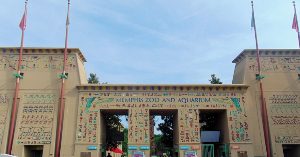
Overall Rating![]()
The Memphis Zoo was founded in 1906. The zoo is located in Memphis, TN. The Memphis Zoo is 76 acres inside Overton Park. Only 55 acres of the zoo is developed which gives them room to grow. They have approx. 3,500 animals representing 500 species. The Zoo is an accredited member of the Association of Zoos and Aquariums and participates in the AZA program called the Species Survival Plan.
Memphis Zoo Website: www.memphiszoo.org
Hours:
March 3rd-October 16th
9:00am-6:00pm
October 17th-March 2nd
9:00am-5:00pm
Ticket Pricing:
Adults (12-59)-$15.00
Seniors (60+)-$14.00
Kids (2-11)-$10.00
Kids 2 & under-Free
Parking: $5.00
(Tuesday’s 2:00pm-close free to TN residents)
Restaurants/Concession:
There are approx. 7 different restaurants located inside the zoo.
Cat House Café, Memphis Grille, Sabino’s, Pranzo’s Pizza, Ray’s Grille, The Outpsot (seasonal), Bamboo Grille, & a few Carts & Kiosks located throughout the zoo.
Pet Daycare: Not available
Service Dogs: Certified Service animals are allowed.
With any extra service provided I would always call ahead for any information.
Animal Habitats![]()
Education![]()
Cultural Immersion![]()
Navigation![]()
Food Variety![]()
For more information on our ratings click here.
Our Zoo Experience
Memphis Zoo Memphis Zoo is in my top five favorite zoo’s to visit. Yes, we have only been the one time in May of 2018, but I would go back in a heartbeat.
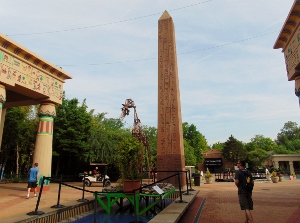
Sometimes when a zoo is very culturally immersive we use shorthand and say it is very Disney like. You know, like when you walk into an African exhibit and you are transported to Africa (Dallas Zoo); or you when you walk into the China exhibit and you feel like you just stepped into the Country of China (Memphis Zoo). Not only are you being transported to the country where a particular species is from, they also have world class habitats.
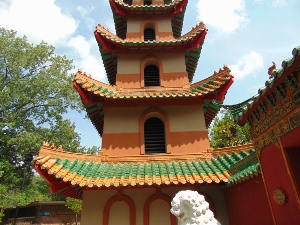
Each animal’s habitat is enriching for the species. I love the Memphis Zoo, so let me tell you how we visited the zoo so you can get excited to visit it too. Like I said previously we went to the Memphis Zoo in May 2018. Yes, it was a bit warm but if you come prepared for the heat you will be just fine.
We arrived at the zoo when it opened at 9:00 am. Oh my gosh the entrance blew me away! I have never seen such a magnificent entrance to a zoo. The entrance for the Memphis Zoo looks like a giant M.
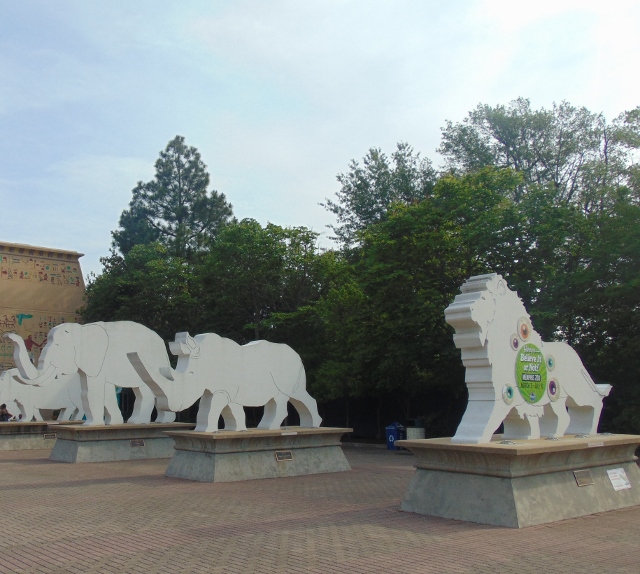
There are 3D (I know sounds weird, until you see it) statues of animals in front of the admission’s gate. The giant M entrance is covered in Hieroglyphs; like what you would see in an Egyptian Tomb.
After you purchase your ticket and gain entry into the zoo, the foyer (so to speak) has huge columns on both sides. Here is where you will find (on the left) the membership office, reception, and the Rendezvous rooms.
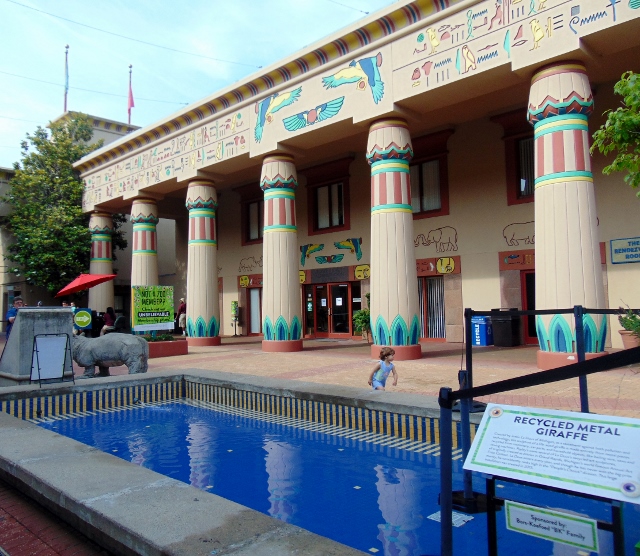
On the right side you will see the gift shop and classrooms. In the center of these towering pillars is a small reflection pool and a giant Hieroglyph covered obelisk.
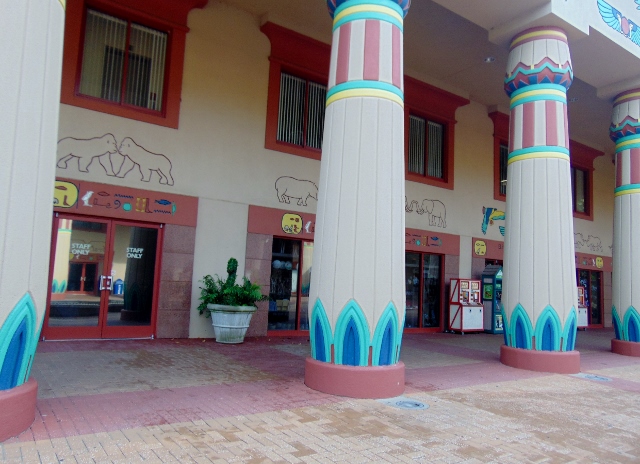
As you make your way further into the zoo straight ahead of you is a wading river and pool in front of the Cat House Café.
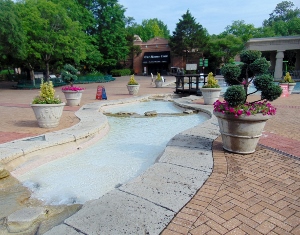
If you don’t want to get wet, you can cross the small beautiful river on a bridge. Before we left for our next adventure I almost sat down in the crystal clear waters of the wading pool. You are only allowed in if there is a lifeguard on duty. There were kids splashing around while the adults soaked their weary feet. The water level in the wading pool maybe came up to my knees.
Ok now on every zoo trip at every zoo the question is should we go right or should we go left? As per usual we went left. Our decision was made based on the cool morning vs. the hot afternoon. When will the most cat species be up and active? Morning before it gets too hot.
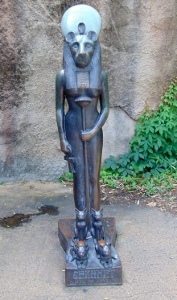
The first habitat we saw was the African Lion habitat. They have plenty of shade and big logs to scratch and lay on. They also have a big waterfall.
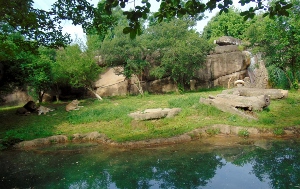
There is a huge open viewing area on the right side of the habitat. This is for when they are soaking up the sun.
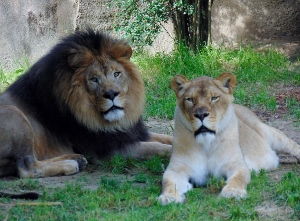
If, however, they choose to be hidden in the shade at the very back of their habitat you can still view them right inside the entrance to the Cat Country exhibit. The male Lion has one of the most beautiful full dark manes I have ever seen.
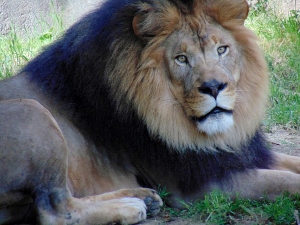
The Commercial Appeal Cat Country entrance matches that of the main entrance with respect to the huge pillars and Hieroglyphs.
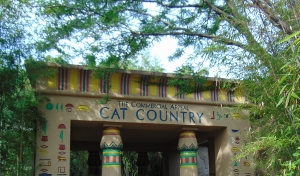
As you walk through the entrance as I stated above to your right you can see the African Lions if they are being shy or needing to cool off. To your left is a remarkable small cat species called the Fishing Cat. Yes, these cats can fish and are very well adapted to the water.
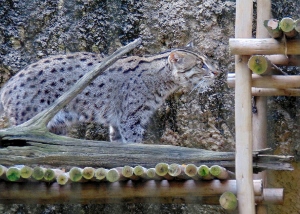
The coolest Tiger habitat is what you will come to next as you make your way down the path. The Bengal and Sumatran Tigers share this habitat, however, they are only out in it one at a time due to Tigers being solitary animals.
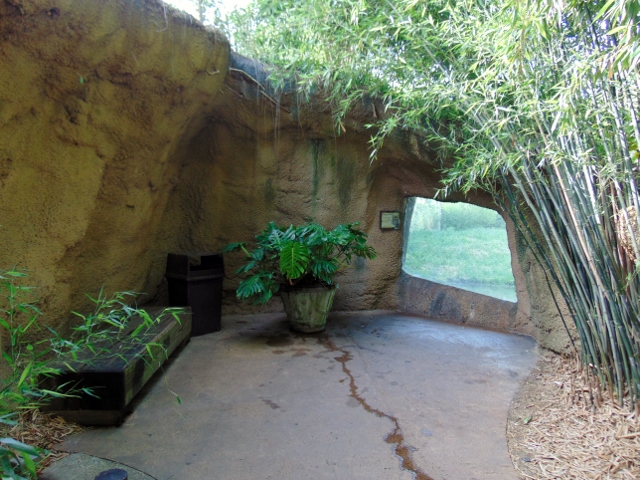
There is a window viewing area if you take a left after the Fishing Cat. If you go right towards the Leopard, across from his habitat through an opening in the trees is a pathway that parallels the Tiger pool. You can view the entire habitat including the awesome ancient ruins and waterfall. It really conveys the Tigers geographical location of their native Asia.
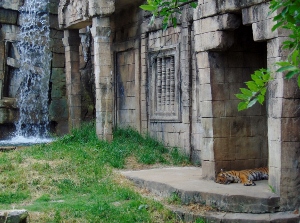
The next species of big cat you will encounter is the African Leopard. This Leopard was enjoying a mid-morning after breakfast nap on a log.
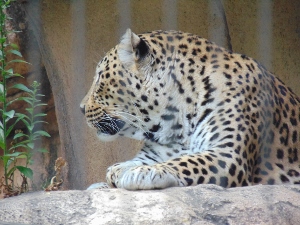
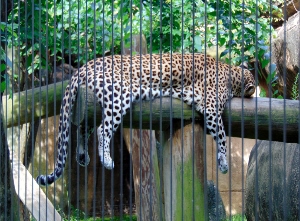
The Cat Country Trail takes you through the different habitats of the other cat species in the exhibit.
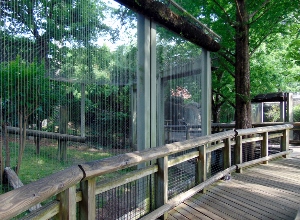
The other species you will encounter are the Jaguar, and Mountain Lion. You can view these beauties from the boardwalk or you can walk up some stairs and enter a cave.
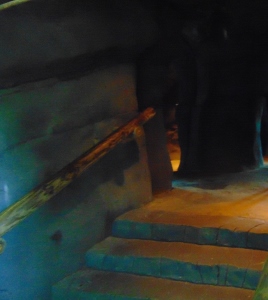
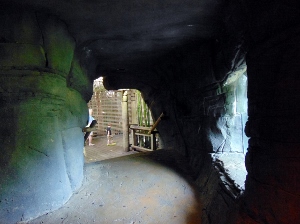
On the right side of the cave is the Jaguar. There is a nice viewing window, and usually this is where you find the Jaguar laying up on the rocks in front of this window.

Across from the Jaguar on the left side of the cave is the Mountain Lion habitat viewing window. Your best bet to see the Mountain Lion, however, is probably from the boardwalk.
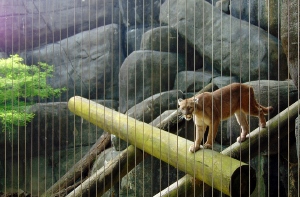
A species in the Cat Country you will encounter is not a cat at all but is the ADORABLE Red Panda. We found her climbing in the top of the habitat’s trees, so cute!
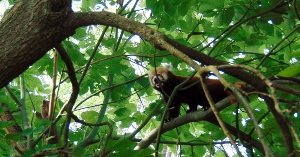
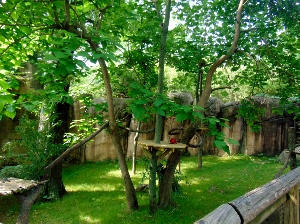
The other two smaller cats (besides the Fishing Cat) in the Cat Country is the Ocelot and Caracal. The Ocelot was lounging on her rocks while the Caracals were perched on their big boulder observing their territory.

Ocelots have a distribution range as far south as the Amazon to as far north as Texas. Caracals are from Africa, and are very accurate hunters. They can catch a bird right out of the air.
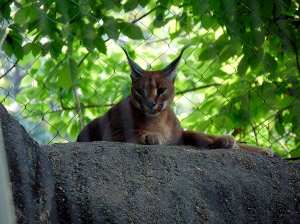
Across from the Caracal’s is the Himalayan Ghost. The two Snow Leopards were sprawled out at the very top of their habitat.
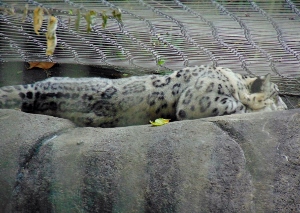
A really common theme for certain big cats is their habitat needs elevation. Snow Leopards, Mountain Lions, Clouded Leopards, Amur Leopards, and Fishing Cats all thrive when they have elevated habitats.
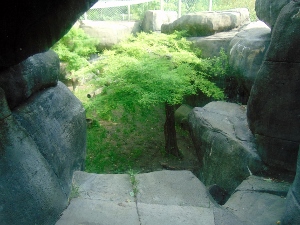
African Lions and Cheetah live on the African Plains and Savannas so they are fine with open grassland habitats. Tigers and Jaguars do really well if there is an area within their habitat that has dense thick brush; they are your Jungle cats.
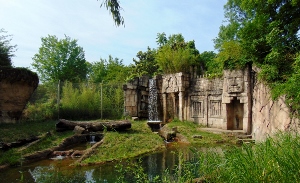
Having visited as many world class zoos as we have, we are building a better understanding what different species need to thrive in a zoo setting. When a zoo goes above and beyond, like Memphis, with different cultural immersion, you are able to learn and understand where an animal comes from.
A great example would be the Tiger and Mountain Lion habitats. In the Tiger habitat, you have ancient ruins that look like the temple ruins in Asia.
Flora (plants) also helps to convey this message. In the Mountain Lion habitat, they have boulders, giant logs, and trees to help tell the visitor these cats are from North America.
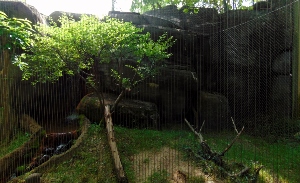
As you round the corner, on the left will be the Meerkat habitat (Steve’s most favorite), and on the right are a couple of Cheetah brothers. Unfortunately, the day we were there, the Meerkats were off exhibit. Sorry Steve.
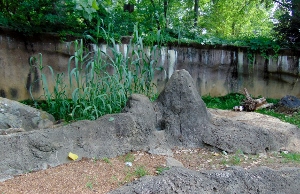
The Cheetah brothers, however, were up and showing off for their visitors. They have a large beautiful habitat. There is a nice pool running the width of the habitat in front. They have shade trees, termite mounds, and a stump to sit on and survey their domain.
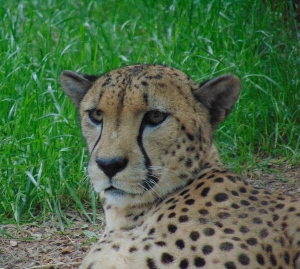

After exiting the Cat Country Trail, we turned left and headed down the path to the Tropical Bird House. In a habitat outside the entrance to the Tropical Bird House is the Toco Toucan.
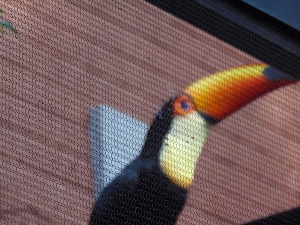
When Steve and I were walking through the Cat Country exhibit, we kept hearing what we thought was some kind of hog species. Well it turns out, it was this guy, and he was a big chatterbox!
When you enter the Tropical Bird House, there is a hallway of habitats with viewing windows on the right side and an open flight habitat on the other.
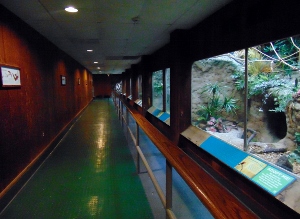
So along the right side of the hallway, you can see multiple species of birds such as the African Pygmy Falcon. These are fierce little Raptors.
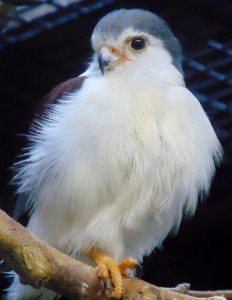
Another species you will encounter, is the Laughing Kookaburra from Australia.
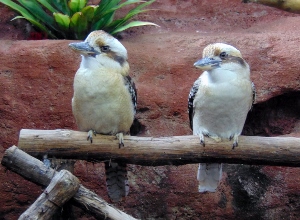
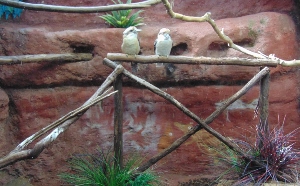
The last species of bird, I really liked, has an awesome habitat and is so cute. It is called a Micronesian Kingfisher. Unfortunately, during WWII cargo ships and planes accidentally introduced the Brown Tree Snake to the Micronesian Islands.
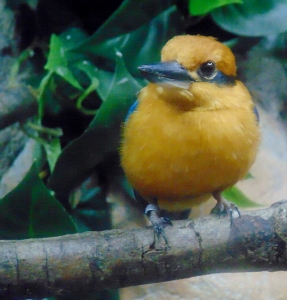
The last wild Kingfisher was seen in 1988. There are eleven zoos in the US and a facility in Guam breeding less than 100 Kingfishers in an attempt to stop the extinction of this remarkable little species. They also have hopes of reintroducing the Kingfisher back to the forests of Guam.
In the open flight exhibit you enter through a doorway and follow a path (horseshoe shaped) to the exit. You can stay in there as long as you want. It’s kind of like bird watching in a controlled Jungle.
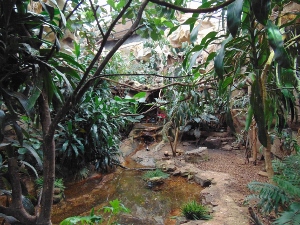
Birds in this exhibit are free flying. It is very well done with massive trees, a waterfall, and a small stream.
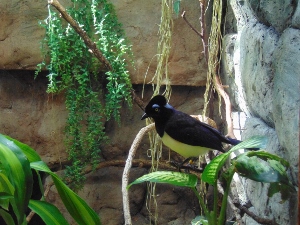
On our way out of the Tropical Bird House (the last habitat) you will encounter one of my favorite birds, the Burrowing Owl.

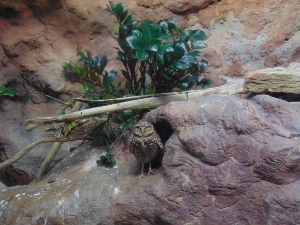
These little guys are so cute! Did you know, they do not make their burrows? They move into ones already built and then abandoned by Prairie Dogs.
After exiting the Tropical Bird House, we continued on to the left and past Sting Ray Bay (open seasonally) and stopped at Penguin Rock.

Before I tell you all about the Penguins, let me mention there is a restaurant called Ray’s Grill (seasonal) next to Stingray Bay. Ray’s Grill offers pulled pork BBQ sandwiches, cheeseburgers, catfish sandwiches, and hand dipped ice cream.
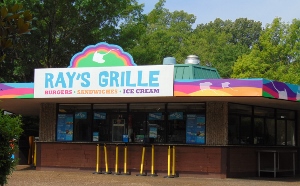
If you are ever unsure of when things will be open at the zoo, check our website, their website, or call and ask the Zoo. Back to Penguins.
Penguin Rock is the habitat for the Zoo’s African Black-footed Penguin. This is a great habitat for the visitor with a 360 degree viewing area. The Penguins were receiving their morning vitamins, so we didn’t get to see them.
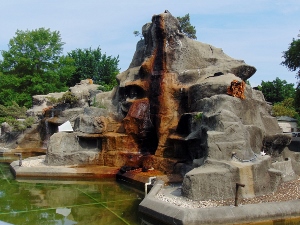
That’s ok though; it just means we will have to come back and visit again. The next species we encountered, across from Penguin Rock, is a Gerenuk.
Gerenuk are from Africa and have very long necks. When they stand on their hind legs, and because of their long necks, they are able to reach leaves most other browsers can’t. I bet you could guess their nickname, it’s Giraffe Gazelle.
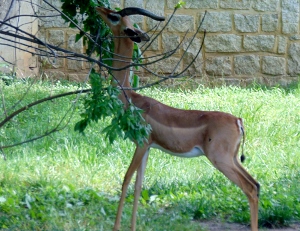
Next to the Gerenuk is the Bat-eared Fox. These little guys have really big ears not only for hearing but their ears also help them shed heat and stay cool. This is necessary to survive the heat of the East and South African Grassy Plains.
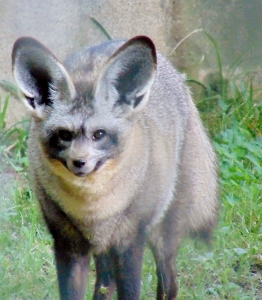
The next African species were new to Steve and I, they are Addara Gazelle and Abyssinian Ground Hornbill.
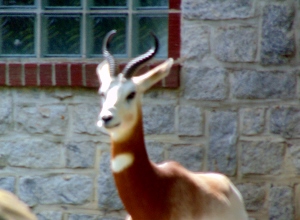
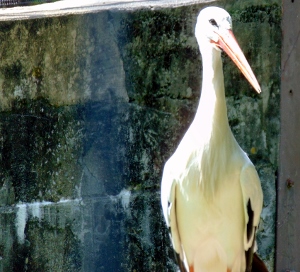
The last species we saw before we walked through the Once Upon a Farm exhibit (Children’s Zoo), is Steve’s favorite Antelope species ever! The Kirk’s Dik-Dik.
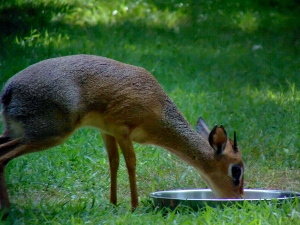
It is one of the smallest Antelope species in the world. These little guys are incredible. They can survive with very little water. They get the moisture they need through the plants they eat. They can be found throughout Southern Africa.
Once Upon a Farm is the Children’s Zoo. It is directly across from the Round Barn where we encountered the Bat-eared Fox and Dik-Dik.
You have to walk under a covered bridge where the Once Upon a Farm Train runs through.
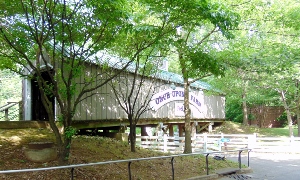
When you enter the farm, on your right is a Butterfly Garden and the left is the Expo Building. As you make your way to the Expo Building, you will notice the Chickens, Geese, and Ducks are free range. Be careful where you step!
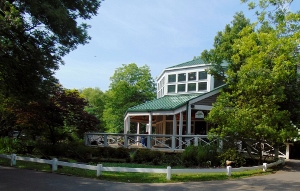
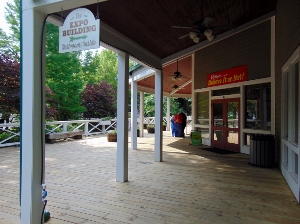
The purpose of the Expo Building is to house an event or exhibition happening at the Zoo. Lucky us, we just happen to be visiting the zoo when the Ripley’s Believe It or Not Art Exhibition was going on.
Basically, there were art exhibits and Ripley’s artifacts all over the zoo. There was a Car Bumper Gorilla and life sized Elephant and calf made of shredded tires.
The most outrageous piece was the Car of Coins we saw later outside of the China exhibit. It was a 1988 Lincoln Continental stretch limousine covered with 23,000 English pennies, each plated with 24 carat gold. Even with the extra weight of the coins, the car is still drivable! Crazy!
Anyway, the Expo Building was showcasing a collection of Ripley’s artifacts. One display was of a Rooster and Hen shaped coffins. I’ll pass, onward!
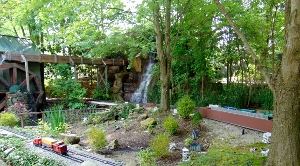
After having fun in the Expo Building, we continued around the farm to see the Pigs, Miniature Donkeys, and the miniature town.
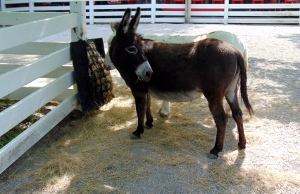
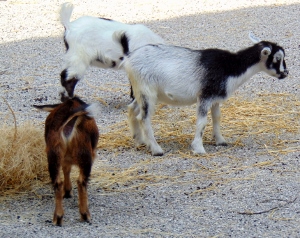
The last habitat you encounter before walking back under the covered bridge, is the Black-tailed Prairie Dog habitat. The P-dogs were off exhibit due to the new sod placed in their habitat.
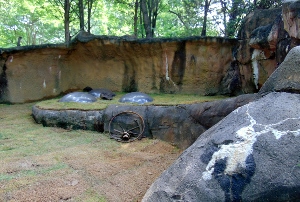
Back on the main trail, we continued left to the Aquarium. It is a small, but very well done Aquarium.
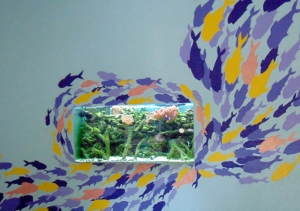
We saw Electric Eels from South America. The most adorable aquatic animals we saw is the Fly River Turtle, or Pig-nosed Turtle. This Turtle is native to the freshwater streams, lagoons, and rivers of the Northern Territory of Australia as well as New Guinea.
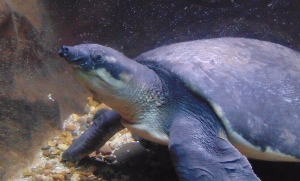
There are Red-tail Catfish, Red-bellied Piranha, Jellyfish called Moon Jellies, and a giant Puffer Fish. It is a really neat little Aquarium.
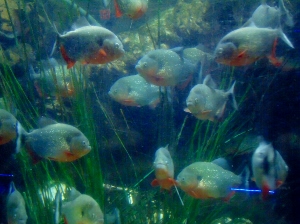
Back to the Round Barn to finish visiting the rest of the African animals like the Red River Hogs and the Warthogs.
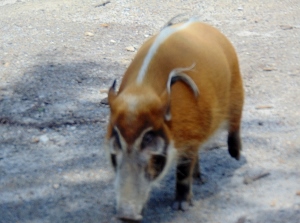
Directly across from the Round Barn is Pelican Bay, where White Pelicans were standing under the shade of their awning.
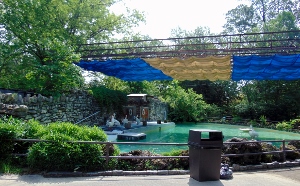
Before exploring the Herpetarium we decided to skip over to the Dragon’s Lair and see the Komodo Dragons and the Tortoises. As we made our way in that direction we passed a beautiful Koi pond.
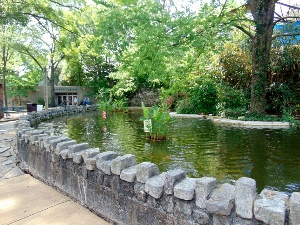
There was a group of students on a guided tour feeding the Tortoises. So we visited with the Komodo Dragons until they were finished as to not interrupt their learning. The zoo has a totally awesome Dragon habitat.
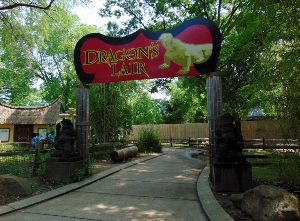
They actually have grass in their habitats. I think they are very hard on plants that are planted in their habitat for them. Anyway, one of the Komodo Dragons living at the zoo is massive, easily reaching nine feet in length. Both Dragons were sunning in the grass waiting on their supper.
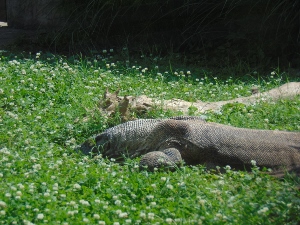
After spending time in the Dragons Lair we were ready for the Memphis Zoo Herpetarium! Their Herp Building has amazing habitats for their Reptile and Amphibians.
We first encountered a Prehensile Tail Skink who was chilling on his rock by the glass. The second habitat is for one of the five largest species of snake in the world, the Burmese Python.
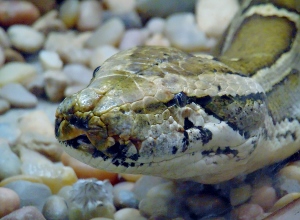

The Herp Building is set up with habitats on both sides and the back wall of the building. Steve and I walked through the Herp Building kind of slow as there were a few new species we had not yet encountered on our previous zoo travels. They also have some of our favorite species too.
I’ll start with the new species, like the Philippine Sailfin Dragon and the Mangshan Mountain Viper. The Philippine Sailfin Dragon will bask on vegetation that hangs out over tropical rivers so it can dive to the bottom quickly to escape danger.
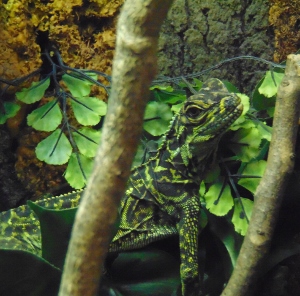
The Mangshan Mountain Viper is extremely rare and found only in a remote mountainous region of China. It was only discovered in 1989.
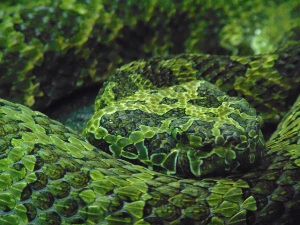
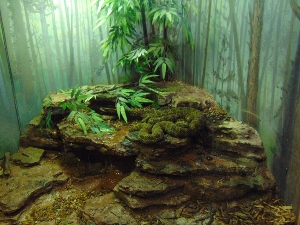
The King Cobra habitat is really awesome, it looks as if it is an ancient Asian Temple. There are carvings of people riding Elephants and there are huge tree roots on both sides of the habitat.
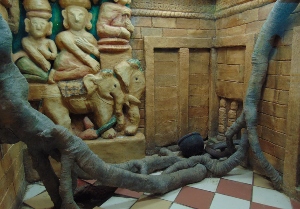
They also have a very large Reticulated Python, it was all coiled up enjoying a nice nap.
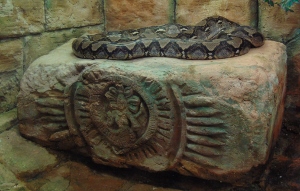
On the back wall of the Herp Building were the larger habitats. One of these habitats is home to the Amethystine Python. This Python has a beautiful color pattern.
Next to the Python’s habitat are three different habitats each with their own pool. The first habitat is home to a Turtle, the third habitat has an American Alligator in it, and the second habitats resident is a West African Dwarf Crocodile. He was at the very back of his habitat and looking rather grumpy.
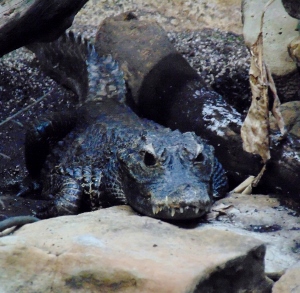
Leaving the Herpetarium we exited onto the main trail and turned toward China. Before we hopped over to China, we stopped by to see the African Bonobo.
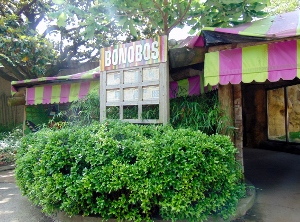
Warning XXX rated! Here is a little something you should know about Bonobos, they enjoy and frequently partake in sex. I know, I know, keep it PG. From a Biological standpoint Bonobos engage in this act for everything from settling conflict to reassuring their bond to one another. Also everyone is included there is no boundary.
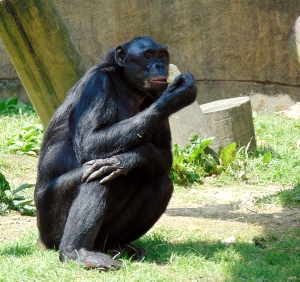
Anyway, I just want to warn you in case you are not ready to have the “brown chicken, brown cow” talk with your little ones.
After visiting the well behaved Bonobos, we went to China. The Memphis Zoo China exhibit is aww inspiring! It takes your breath away when you step through the gates.

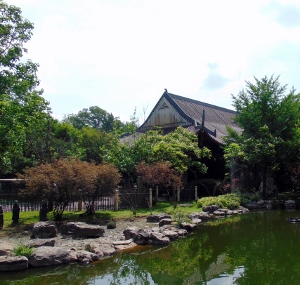
Ok here is a little bit of the back story on how China at the Memphis Zoo came to be. You can read this story on a mural between the Sulawesi Crested Black Macaque and the Giant Panda’s outdoor habitats.
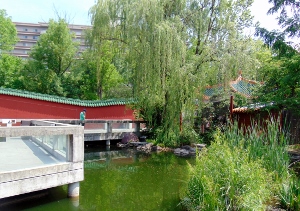

Let me paraphrase here for you, the U.S. Ambassador to China was from Tennessee, Memphis specifically if I recall correctly.
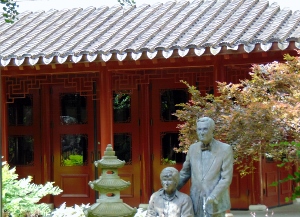
He was able to negotiate for two Giant Pandas to be brought to the Memphis Zoo as long as they were completely culturally represented and had exceptional facilities. As you can see from my pictures the China exhibit is definitely in my top five exhibits.
As you enter through the gates into the square you are transported to Chine through the detail and architecture. To the left is a beautiful Zen Rock Garden.
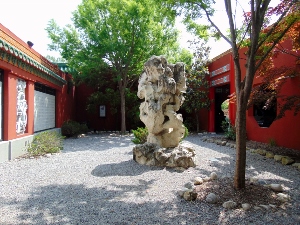
If you continue straight past the giant dragons you step out into this beautiful lush garden with a pond.
To the left is the Sulawesi Crested Black Macaque habitat. Their habitat is huge with plenty of stuff to climb on or hide behind. These Macaques live in rainforest and are one of the few Monkeys without a long tail, which sometimes confuses people who mistake them for Apes.

Continuing ahead around the corner is the Giant Pandas outdoor habitat. The day we visited LeLe and YaYa were in their “Dayrooms” staying cool.
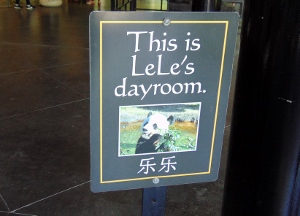
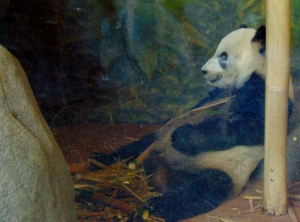
Steve and I had not previously seen a Giant Panda in our zoo travels. Their relatively small size surprised me. They were in their “Dayrooms” happily munching away on Bamboo.
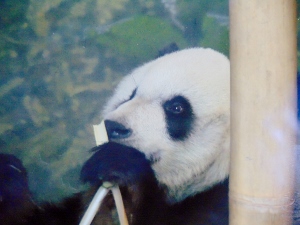
It was amazing to be so close to them as they sat on their bottoms and gripping the Bamboo shoots with their hands.
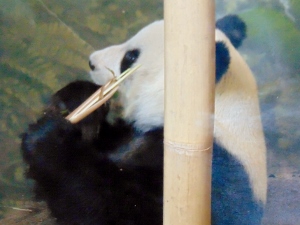
Steve and I stood there at their “Dayroom” habitats for quite some time just watching them. On the other side of the Giant Panda habitat is the Francois’ Langur and across from them was another beautiful garden with a prayer pagoda.
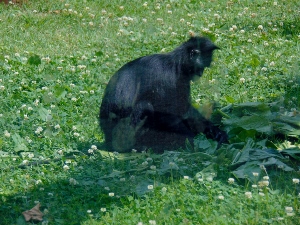
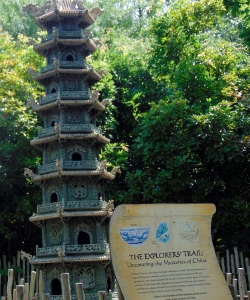
You can follow the path around to the right and one of the last habitats you will encounter is the Pere David’s Deer. It had rained the night before and that morning so they had a few mud puddles etched out in their habitat.
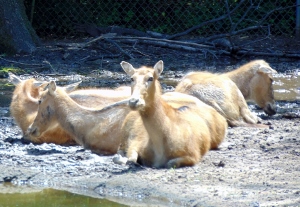
This is completely ok because this species of Deer actually prefers marsh land and is native to the subtropics of China. Did you know these Deer are semi-aquatic? This species status right now is extinct in the wild.
Directly outside the China exhibit is the seasonal concession Bamboo Grill, Steve and I weren’t really hungry so we decided to trek to the next exhibit. A few items offered at the Bamboo Grill include fried chicken and waffles and waffle fries with buffalo chicken, bbq, or bacon.
Welcome to the African Veldt.
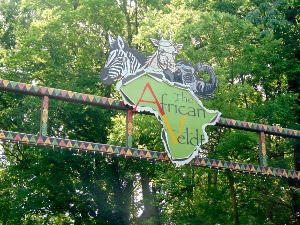
The first African habitat and species you will encounter is the Thompson’s Gazelle and Ostrich.
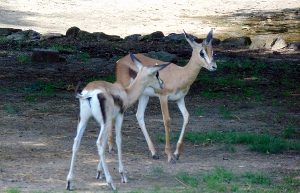
For the Plains herbivores it is not any problem to let them share a habitat. It is often great enrichment to have different species cohabiting just like they would in the wild.
Directly across from the Plains is the African Elephant habitat. The Memphis Zoo is home to three African Elephants. The oldest Elephant in the group is Tyranza (Ty), she was born in 1964.
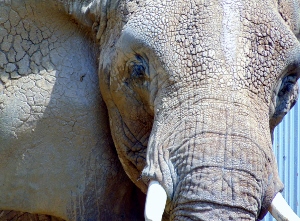
Next to the Elephants is the Southern White Rhino habitat. The two Rhinos were hanging out near the front of their habitat, we were able to get a really good look at them, as they were super close to us.
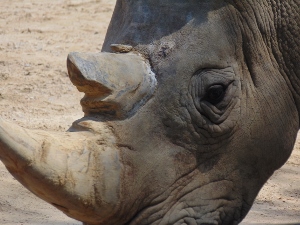
Did you know… the White Rhinos’ name actually happened by accident? When a German Biologist called them the “vide” Rhino, referring to its “wide” upper lip, his was misunderstood to say “white”. The lips of a Rhino is also how you can tell the African White from the Black Rhino.
After visiting with the Rhinos we decided it was time for a snack. We stopped at the Outpost, a concession between the Southern White Rhino habitat and the Camel rides.
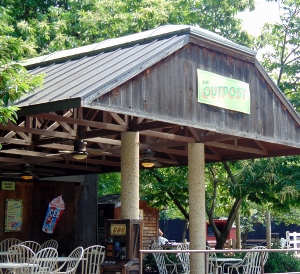
The Outpost has your normal concession stand fare like Chicago-style hot dogs, chili cheese nachos, and bbq nachos.
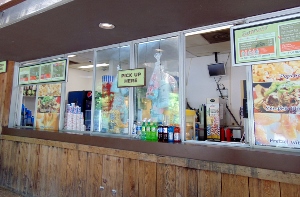
Steve and I were not starving, however, we needed something to tide us over until we got back to the Cat House Café. We enjoyed a piping hot pretzel with cheese and shared a soft drink.
Twenda (let’s go) to the Northwest Passage and Teton Trek! The Northwest Passage entrance is incredible, the whole exhibit is AMAZING! At the entrance to the NW Passage are three big Totem Poles from the Inuit culture.

As you walk in the gift shop is to your left.
The first habitat and species you encounter is the Polar Bear. You can turn left and see the habitats rocky cliffs or you can walk inside to view his underwater pool. There are seats on the left to watch the Polar Bear swimming and enjoying his habitat.
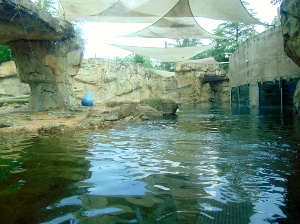

Across from there is another set of seats in front of the Sea Lion viewing window. The Sea Lions were in their pool swimming and enjoying the cool water on this hot day.
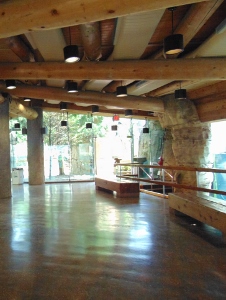
Exiting the indoor viewing building take the path to the left. Here you will encounter American Black Bear and American Bald Eagles. There are three Black Bears at the zoo.
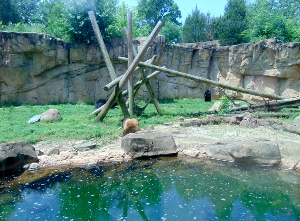
They were busy foraging when we visited their habitat. They have a big beautiful habitat with a pool for them to cool off in as well. At the Black Bear habitat you will turn right and walk up a small incline to take the trail to the Bald Eagles.
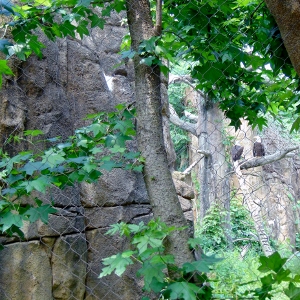
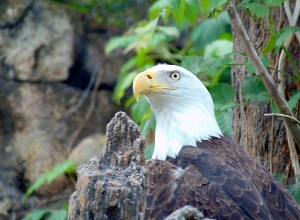
Before you do check out the rock wall by the Black Bear habitat. Steve found cracks in the rock labeled Polar Bear Sniffing Crack. So the idea is the Polar Bear can smell you through these small cracks, which provides great enrichment for them.
Ok on to the Bald Eagles. As you walk down the path there is cultural immersion all around you. The trees and shrubs are what you will find in the Northwest.
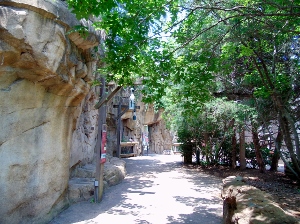
Then there is all the Inuit artifacts. You can see a dugout canoe and a model of a Salmon drying rack.

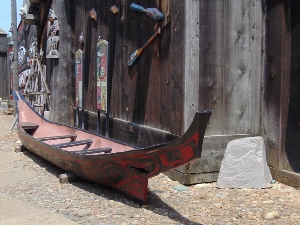
It was breathtaking walking down the path. There were three American Bald Eagles sitting in one of their trees in their habitat watching people as they stopped to visit with them. This is the best Bald Eagle habitat I have seen to date.
The trees are tall and there is enough room in their habitat the Eagles could make short flights if they wanted to. Five Paw American Bald Eagle habitat.
As you exit the Northwest Passage there is a Statue and Quote from Chief Seattle next to a beautiful waterfall.
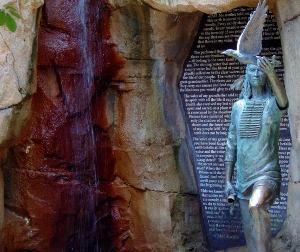
When you leave the Northwest Passage turn left back on the main trial to head to the Teton Trek. The Teton Trek resembles the ecosystem and species found in Wyoming and surrounding states.
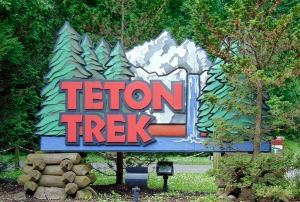
To start you will trek up a slight incline for most of the way around the Teton habitats. The first habitat you will see is the American Elk habitat.
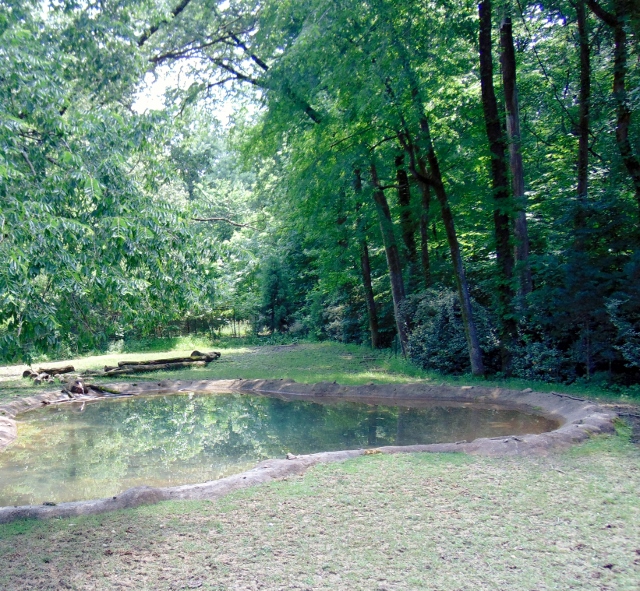
They have a huge open habitat with plenty of grass and shade. The herd was laying down in the shade when we were there. I counted a bull and his harem of four cows. I love the sound an Elk makes when they bugle.
Across from the Elk with a beautiful habitat is the Timber Grey Wolf. There are four adults in this pack. They are beautiful.
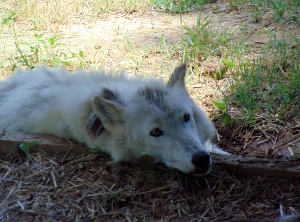
They have mostly white fur, however, Timber Wolves come in many colors. These guys were lounging around in the heat of the afternoon.
As you continue up the trek you are still ascending until you reach Grizzly Falls, then you will slowly work your way back down. Before you do, I highly recommend looking out upon the Grizzly habitat.
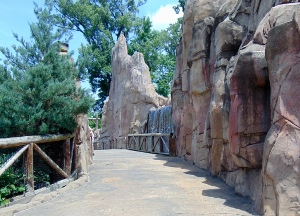
It is like you have really traveled to the Tetons, you know, except for the annoying heat.
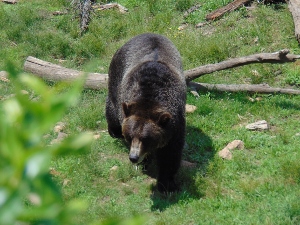
The zoo has three adult Grizzly Bears. The day we visited them, they were having a ball playing and splashing around in their river and pool. The waterfall (Grizzly Falls) supplies the water for their river and pool.
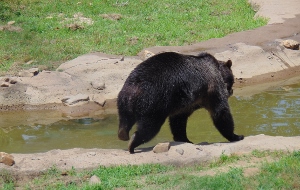
As you descend down toward the Grizzly’s underwater viewing area there is a pond for Waterfowl and a Ranger Station up in the trees on your right.
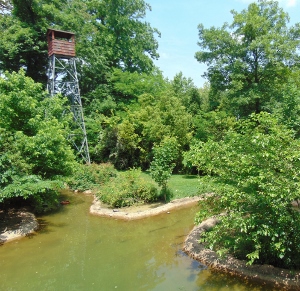
There is a covered viewing area at the bottom of the Teton Trek. Here you can watch the Grizzly Bears as they frolic in their pool.
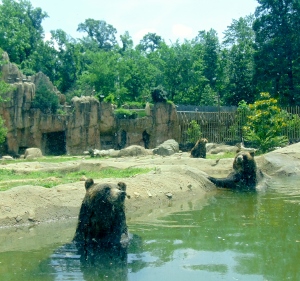
After we watched the three boys for a bit we made our way to the exit at the Teton Trek by way of the Teton Trek Lodge.
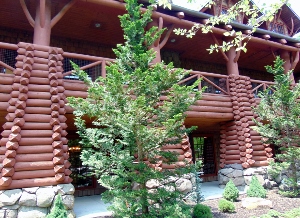
This stunningly massive two story lodge is amazing! It is a log cabin lodge with a huge stone fireplace. There are plenty of tables and chairs if you want to sit and have lunch, or just sit and visit.
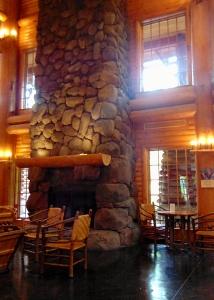
There is both a beautiful staircase and an elevator to reach the second floor. I recommend going up and checking out the view over the Grizzly habitat. There are also big flat screen TVs with movies about this area of the U.S
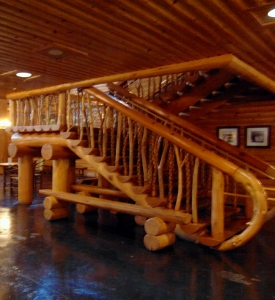
In front of the Teton Trek Lodge as you exit is a splash pad. There were several little kids playing in the cool water as we exited the lodge. Across the main path is a large number of picnic table to grab a seat, take a rest, or eat a snack or lunch.
Onward we must go toward the Giraffe and the Zambezi River Hippo Camp. Directly before you get to the Zambezi River Hippo Camp take a right to view the Giraffe, Zebra, and Scimitar Horned Oryx. All three of these species were in the shade on this hot May day.
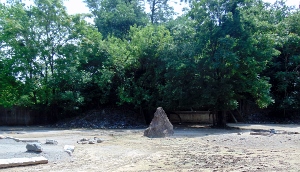
Head back down the way you came and turn right to continue on to the Zambezi River Hippo Camp.
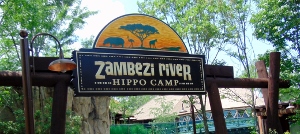
The first habitat you come to is the Nile Crocodile. These guys are the second largest species after the Saltwater Crocodile. Nile Crocodiles can grow up to sixteen feet and weigh over 1,000 pounds. As you walk along the Croc habitat you will see the underwater viewing area.

When you enter the African hut, you can climb the stairs or ride the elevator to the upstairs veranda (wrap around porch) to see out over the Croc and Hippo habitats. More on the Hippo in just a minute.

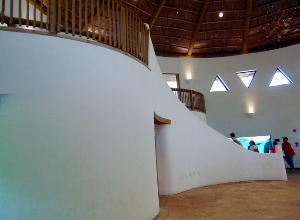
Before you do enter the main hut take a right and walk the loop into the Zambezi River Hippo Camp Aviary. It is a beautiful small aviary.
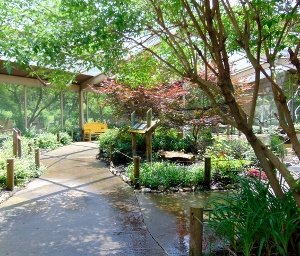
Once you are back at the main hut and have made your way up to the veranda you can look out over the Nile Crocodile and Hippo habitats. The Nile Crocodile was laying in the grass soaking up the afternoon sun.
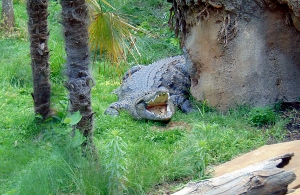
Crocodiles like most Reptiles are cold blooded, meaning they rely on the sun to help regulate their internal temperature. Ever notice when it is cold outside you don’t see any Reptiles, but the second it warms up there are Toads. Frogs, Turtles, and Snakes everywhere? They are ectothermic. When you see an Alligator or Crocodile laying out of the water with their mouth open, they are regulating the body temp. They have gotten too warm.
Walk around the African hut, the Hippo pool is across from the Nile Croc. The Hippos were under the water so we had to go down to see them at the underwater viewing area.

To get down to the ground level you can either take the stairs or elevator inside the hut, or you can take the stairs that lead to the big patio area.
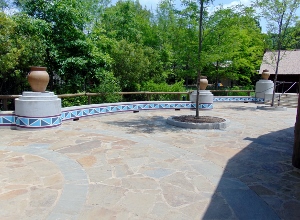
Then follow the path to the Nile River Hippo covered underwater viewing area. Did you know…Hippos can sleep underwater? They can even resurface for air without waking up. This Nile River Hippo even had the cutest little baby Hippo right beside her.
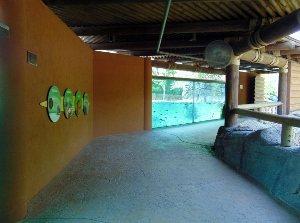
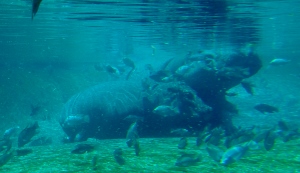
As you move on down the trail you can play some African drums or snap a photo in front of a Safari Jeep.
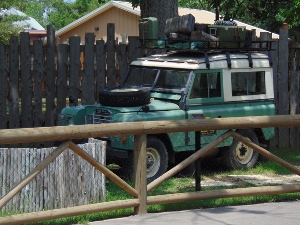
The next habitat in the Hippo Camp is the Okapi and Nyala. Steve and I couldn’t recall ever seeing the species Nyala before. Nyala are even-toed ungulates that live in South Africa in dense thick brush close to a water source.
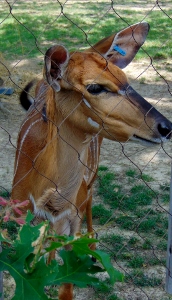
Across from the shy Okapi and not so shy Nyala is the Lesser Flamingo habitat. There is some beautiful coloring and scenery at the Flamingo habitat.
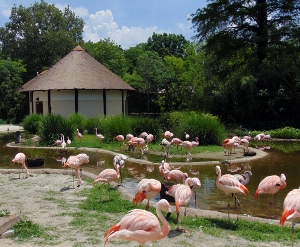
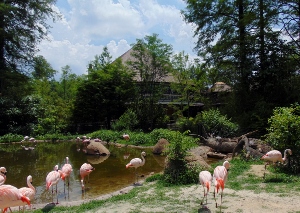
The last habitat in the Hippo Camp is the Mandrill habitat. Everyone SHOULD know what a Mandrill is. Have you ever watched the Lion King?
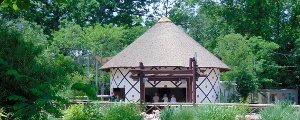
Do you know who Rafiki is? He is a Mandrill! The best part is Rafiki means “friend” in Swahili. Well, in the real world Lions and Mandrills are not friends.
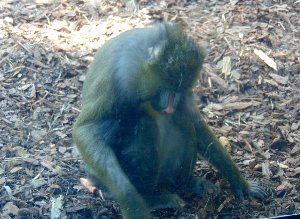
As you exit the Zambezi River Hippo Camp back on the main trail, take a right to enter the Primate Canyon Trail. There are two entrances to the Primate Canyon. You will want to turn left at the second one as to not miss the Primate Pavilion. We did not realize until after we were home that we missed the Primate Pavilion.
After the Primate Pavilion on the right you will encounter Sumatran Orangutan or Siamang. These two species take turns sharing this habitat. The day we were there was Orangutan day.
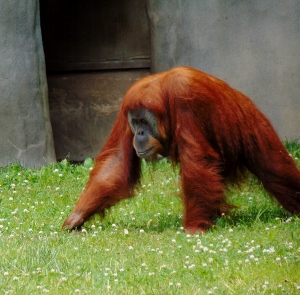
Now I am not sure if this is an all-day event or if they switch halfway through the day. Unfortunately we did not see a Keeper to ask and I did not see any signage with that information available. My guess which ever Primate is not out on exhibit is in the Primate Pavilion.
Further research is needed, I guess that means another visit will have to happen! Darn! On the left is the Asian Small-clawed Otter, Black and White Ruffed Lemurs, and Red Ruffed Lemur habitat. The Asian Small-clawed Otters, all SEVEN of them, had the outdoor habitat that day.
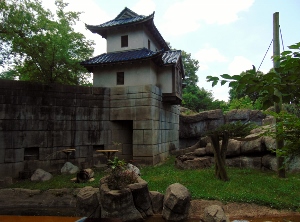
The Orangutan were relaxing in the grass, it looked like they had just recently had a party with some cardboard boxes and cardboard people.
The Otters were all snuggled together on a big rock in their habitat. Did you know…Otters have special glands that secret oil they then rub all over their fur? This oil helps keep them waterproof, the water essentially does not even touch their skin. Therefore, they are able to survive in colder temperatures. Asian Small-clawed Otters are the smallest of all the Otter species, and they are ADORABLE!
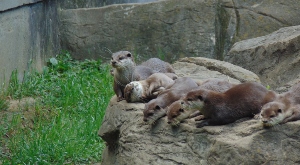
Other small Primates in the Primate Canyon include Baboon, Black and White Colobus Monkeys, Patas Monkeys, Spotted-nosed Guenon, and White-cheeked Gibbon to name a few.
Gibbon use their long strong arms and hooked fingers to Brachiate (or swing hand over hand) swiftly from branch to branch. If you ever see a Gibbon walking on the ground most of the time they will have their arms above their head.
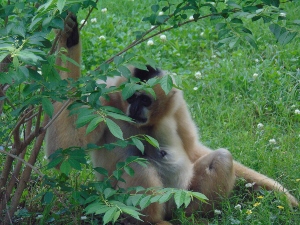
The last but certainly not least in Primate Canyon is the powerful Western Lowland Gorilla.
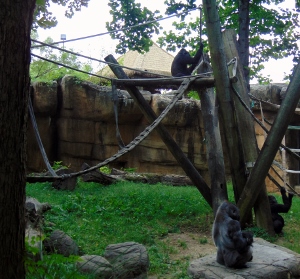
The big beautiful Silverback Gorilla was pouting about something when we walked up.
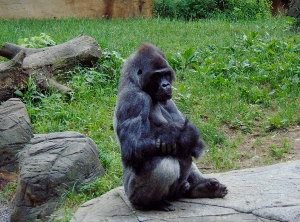
In fact most of the troop looked pouty. I think they were ready for their supper or maybe they were hot like we were. It was hot that day.
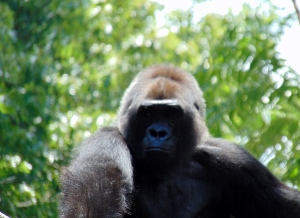
When leaving Primate Canyon there are observation towers on both sides of the trail. The towers has a waterfall under the right one and a small stream and pool under the left one. In the pool we saw a very large Turtle.
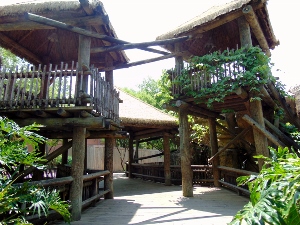
When you get back to the main trail you can turn right, this will take you to the Animals of the Night exhibit.
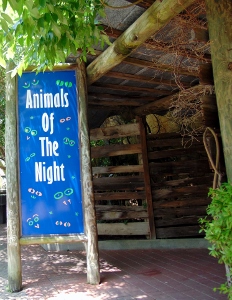
I was so excited for this exhibit! Unfortunately it is dark, I mean they painted glow in the dark arrows on the floor and walls DARK, so I did not get to take any pictures. Very sad! STILL, I was very excited because there are so many species Steve and I had not yet seen on our zoo travels!
The first thing you should do is let your eyes adjust to the darkness. Like I mentioned above, they do have everything very well marked, and it is almost impossible to not see where you are going. Second, take you time! Some of these animals are so rare and endangered this may be your only chance to EVER see them.
The first thing you see when entering the exhibit is a neon tree (Tree of Life). This is when your eyes have the chance to adjust.
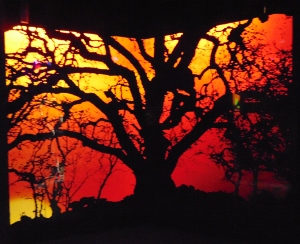
The first habitat and species you encounter is the Two-toed Sloth. Next to the Sloth is the most adorable and rambunctious nocturnal Greater Bushbaby. One species I was really excited to see was the Bear Cuscus. Cuscus are Marsupials like the Kangaroo or Opossum. This species is endemic (found nowhere else) to Sulawesi and can be found in the islands tropical forests. Sulawesi (for those who don’t have a map laying around) is a remote island in Indonesia. Memphis Zoo is the only zoo in the U.S. exhibiting this very special species.
Another amazing animal in the exhibit is the Tamandua. Tamandua are related to the South American Giant Anteater. Tamanduas (Lesser Anteater) are mostly arboreal and will use their powerful long claws to tear open Ant dens in the forest canopy.
The Memphis Zoo is also home to Aardvarks and African Crested Porcupine. I tried everything I could think of with my camera to get a picture of their Aardvark. However, this little tunnel digger is super-fast.
In with the Bushbaby is the Agouti, think of them as the responsible kid at the party who goes around pick up after everyone.
One of the largest nocturnal animals Memphis Zoo has in their Animals of the Night exhibit is the Binturong. Here is a fun and weird fact, Binturongs smell like buttered popcorn. They are related to the Civet and Mongoose.
A few rare species we saw in the Animals of the Night building are the Mongoose Lemur, Pygmy Slow Loris, and a Slender Loris. Another favorite I got to see for the first time was a Kinkajou, also known as the Honey Bear. They are closely related to Raccoons.
Two of the most interesting species in the exhibit are the Spotted Genet and the Wombat. Even though Genets are about the size of your House Cat and have been heard purring and hissing they are in fact not feline. They like the Binturong are Viverrids.
Wombats specifically the Hairy-nosed Wombat at the Memphis Zoo are nocturnal Marsupials from Australia. Southern Hairy-nosed Wombats are so good at digging they are nicknamed the “Bulldozers of the Brush”.
“Warrens” are what the Wombat’s complex tunnels are called. These burrows have several entrances (for quick access) and are only as wide as the Wombat that digs them. The burrows can be up to 100 feet long and around six feet deep.
A Wombats pouch, where the baby develops after birth, face backwards so the baby doesn’t get a face full of dirt when the mama Wombat is digging.
One fun (well I find it fun) fact I know about Wombats is that they poo square poo. Why you might ask? One theory is that square poo doesn’t roll, so the poo stays put wherever it is laid. This could be helpful for scent marking their territory. Well that is it for the Animals of the Night exhibit.
When we exited the exhibit we turned right and entered the Cat House Café. Inside the Cat House Café are three different restaurants, Memphis Grille, Sabino’s, and Pranzo’s Pizza.
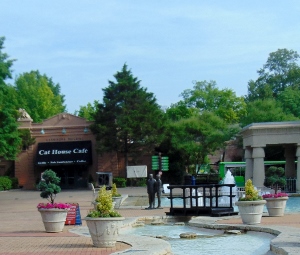
Memphis Grille offers burgers, Catfish sandwiches, chicken fritters, and a killer spicy black bean burger. Sabino’s has fresh made to order deli subs, salads, soups, and chili. Pranzo’s Pizza is fresh hand-tossed personal pizzas.
After Steve and I were finished eating we made our way to the gift shop to purchase our magnets. Memphis Zoo is one of my favorite zoos, with all the unique species we got to see. We will definitely be visiting again soon!!